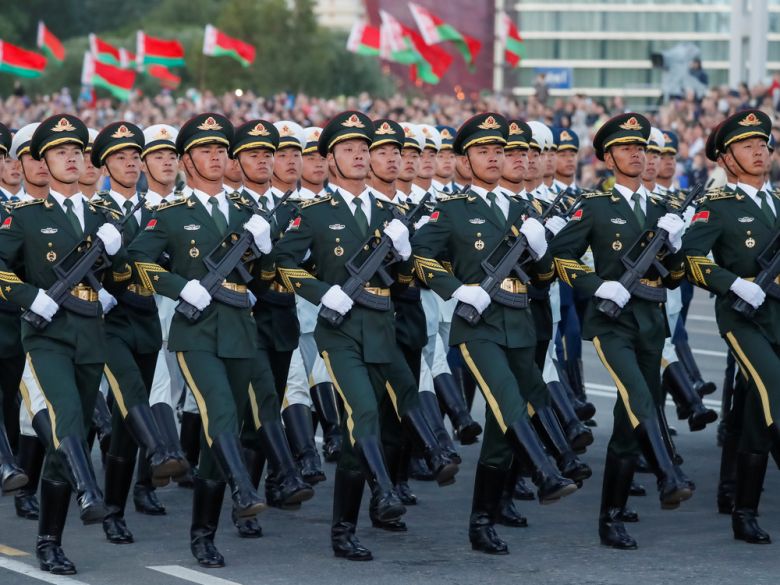BEIJING — China sharpened its hostility toward the United States and Taiwan in a new high-level report on its future military strategy that accused Washington and its allies of undermining global stability.
Releasing the document on Wednesday, officials of the People’s Liberation Army repeatedly warned that Beijing would be willing to deploy military force to assert its claims over Taiwan. The self-ruled island has pulled closer to the Trump administration and agreed this month to buy $2.2 billion in weapons, including M1A2T Abrams tanks and Stinger missiles.

Taiwan’s incumbent Democratic Progressive Party favours declaring formal independence from China, a move that could spark confrontation in the Taiwan Strait, one of the world’s most heavily militarized flash points. China’s navy this month sailed its sole aircraft carrier into the strait in a show of force reminiscent of similar U.S. operations two decades ago that showcased American military dominance in Asia.
“If anyone dares to separate Taiwan from China, the Chinese military would not hesitate to go to war,” Chinese military spokesman Wu Qian said as he laid out what officials called a revised national defence policy for “the New Era” — a catchphrase that denotes the imprimatur of China’s assertive leader, Xi Jinping.
The military blueprint comes as tensions simmer in the western Pacific and China moves to enforce its strategic aims across the region, including in the disputed South China Sea. Beijing views democratically ruled Taiwan, which separated from the Communist-ruled mainland in 1949, as a renegade province.
Global military competition was rising, with the United States “strengthening its Asia-Pacific military alliances” and engaging in “technological and institutional innovation in pursuit of absolute military superiority,” the white paper noted.
If anyone dares to separate Taiwan from China, the Chinese military would not hesitate to go to war
The white paper, China’s first in four years, noted that the Trump administration had “adjusted” the U.S. national security posture to regard China as a rival and claimed “hegemonism” was on the rise – a clear reference to the United States.
Washington “has provoked and intensified competition among major countries, significantly increased its defence expenditure, pushed for additional capacity in nuclear, outer space, cyber and missile defence and undermined global strategic stability,” the Chinese document said.
The paper couched its assessments by describing the situation in the Pacific as “generally stable.”
Tensions soared this week, however, as China and Russia flew bombers on a joint patrol into airspace claimed by Japan and South Korea, leading Seoul and Tokyo to scramble fighter jets. South Korean military officials say they fired warning shots at the Chinese-Russian sortie.
The patrol was widely seen as a demonstration of growing cooperation between Beijing and Moscow, especially given the alleged incursion into airspace claimed by two key U.S. allies in Asia.
“As Sino-Russian relations enter a new era, the Chinese and Russian militaries will continue to push military relations to new, historic highs,” Wu said when asked about the patrol.

Speaking to reporters Wednesday, military officials hailed Xi as “commander in chief,” a title that has not been accorded any other Communist Chinese leader. Following years of purges within the military to establish its fealty, Xi began assuming the title in 2016 as a symbol of his political control.
Andrew Erickson, a Chinese military expert at the U.S. Naval War College, said the new white paper did not outline qualitatively different strategies but sent a political message.
“It reflects Xi’s self-dictated era, strategy, goals, reforms, and rhetoric,” he said.
“The report contains strong rhetoric doubling down on domestic stability imperatives and sovereignty claims vis-a-vis Taiwan and the East and South China Seas.”
- John Ivison: Diplomatic support for Taiwan may offer Canada leverage in dispute with China
- David J. Bercuson: Despite China’s might, Taiwan would fight to be free
- John Ivison: Time for Canada to play the same strategic game China is playing against us
- Many in Hong Kong moving to democratic Taiwan to escape China’s looming grasp
The document said a distinctive feature of its new strategy is that China would not seek a sphere of influence or regional hegemony because “since the beginning of modern times, the Chinese people have suffered from aggressions and wars.”
As of 2017, the People’s Republic’s defence spending was hovering near a record low as a percentage of government spending, at around 5.14 percent, the paper said, which showed a “clear downward trend” despite Xi’s ambitious modernization drive.
U.S. defence spending, by comparison, accounts for roughly 15 percent of federal expenditures.

























